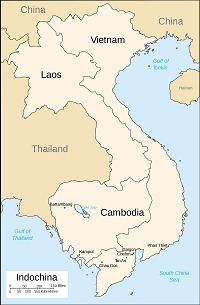Period 1978 – 1991 | ||
 | ||
Third indochina war alternate history
The Third Indochina War was a series interconnected conflicts in Indochina after the fall of the South Vietnam to the Socialist Republic of Vietnam in 1975 and lasted from 1978 until 1992. While the direct cause of most of these conflicts can be seen to be the end of American involvement in the Second Indochina War, known in the US as the Vietnam war, it was far more about the shifting alliances of the various republics in the region as the Soviet and Chinese foreign offices fought over the regions influence.
Contents
Background
Main Article(s): Vietnam War, Sino-Soviet Split
In 1954, Joseph Stalin died, and after a brief power vacuum, Nikita Khrushchev succeeded him as the most powerful man in the Soviet Union. This angered China, as Mao Zedong had been good friends with Stalin, and saw Khruschev as a direct threat to Mao's agrarian economic policies and the Maoist insistence on the cult of personality as a unifying force of the nation. China officially split from the USSR in 1956, when in a speech to the Soviet government, Khrushchev denounced Stalin and pushed for expelling his influence from the government. A series of incidents during the late 1960s cemented the Soviets and the Chinese as opposing forces of communist influence across the globe. As decolonization movements began to pick up speed in the 1960s, and more and more movements descended into violence, both of the communist powers competed for political control of the new nations, or competing factions in ongoing fights in civil wars.
Meanwhile in Indochina, since 1952 American Forces had been fighting against the communist Democratic Republic of Vietnam, which was secured in the North of the country, while it supported the anti-communist Republic of Vietnam. This fighting often spilt over into Vietnam's neighbours, especially as the John F. Kennedy's administration began U.S. involvement in the war proper, and as the Richard Nixon's administration tried to escalate the war in its later stages. This escalation led to the destabilisation of Vietnamese neighbours. The first was Kingdom of Laos, who was taken over by communist militias in the 1970s, after a brief civil war between the Royal Lao Army and the Soviet-backed Pathet Lao. This facilitated first the creation of the Lao People's Democratic Republic and drew the first battle lines of the upcoming war. It also led to the Vietnam People's Army occupying some areas of southern Laos in order to move the Ho Chi Minh Trail through these regions.
As the Vietnam War progressed, American involvement lessened, and by 1975 American troops had completely left the country. This allowed the communist Vietnamese to enter Saigon largely unopposed and declared themselves the sole government of Vietnam. While at first closer to the Chinese, due to assistance during the war and general closeness, the government soon drifted apart, due to ideological differences, and pressures from Russia.
Cambodia
After the 1954 Geneva Conference, Cambodia restored its monarchy under the authoritarian and isolationist regime of Prince Norodom Sihanouk, who sought to be neutral as the region descended into violence. Cambodia, however, descended into political violence further in 1968 after a group of Maoist-influenced rebels rose up in the nation and began an insurgency against the royalist forces, led by Pol Pot and calling themselves the Khmer Rouge. During this time, Vietnamese forces, under attack by U.S. troops, fled into Cambodia, expanding the Ho Chi Minh Trail into the nation, and established camps to continue the war on a front with South Vietnam. Sihanouk saw these forces as equal threats against his rule and began a brutal campaign against all communist forces in the country, especially in the northeast.
The U.S. meanwhile began to view Sihanouk as more and more of a threat to the ongoing war efforts in the region. This is because during the opening stages of the Khmer Rouge insurgency Sihanouk had cut off diplomatic relations with America, and his movement into the northeast had caused ARVN advisors to begin fearing of a Cambodian invasion. As a result, America began a bombing campaign into Cambodia. The bombing, and the subsequent invasion by the U.S. military and destabilised the nation. In 1970, a U.S. backed coup ousted Sihanouk and established the Khmer Republic. Though initially liked by the elite of Cambodia, the republic became more and more dictatorial as the war against the Khmer Rouge continued.
During this time, America continued its bombing campaign against Cambodia, leading to huge amounts of civilian deaths. The Khmer Rouge used the campaign as recruiting material for the largely ignored and angry peasantry of Cambodia. The Khmer Rouge also started to centralise around Pol Pot, who took power in 1962. Pot took the opportunity to purge the party, and the party became increasingly focused around the worship of Pol Pot. The Khmer Republic fell in April 1975, when the Khmer Rouge entered Phnom Penh, and ousted the Republican government, officially declaring alliance to Pol Pot.
Start of the Conflict: 1975–1980
Main Articles: Cambodian–Vietnamese War, Sino–Vietnamese War, border conflicts
After the Fall of Saigon and Phnom Penh within the same month, and the subsequent communist takeover in Laos 5 months later, the Indochinese region became fully controlled by communist governments. The new Cambodian government was extremely antagonistic to other members of the region, capturing Vietnamese islands less than 24 hours after the fall of Saigon.
It consisted of:
